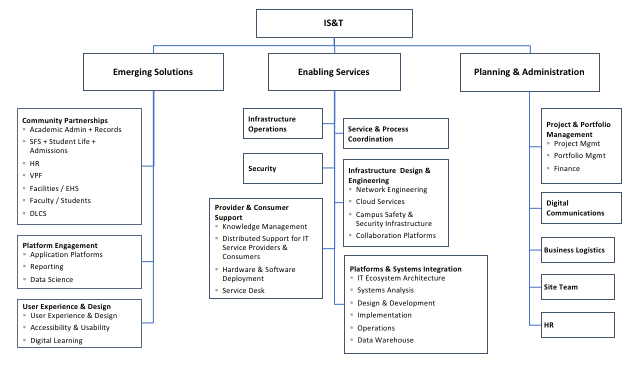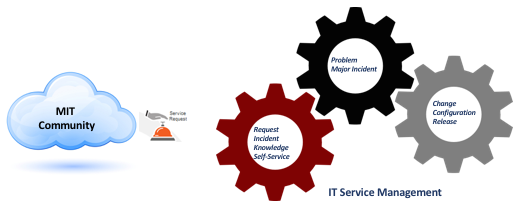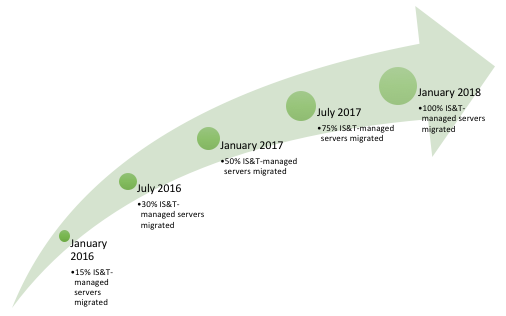Implementation of the strategic plan for realizing the 2020 Vision began with the announcement in February 2015 of a new operating model and structure for the Information Systems & Technology organization. This move to a more agile, responsive operating model involved transformations in people, process, and infrastructure to bring about enhanced ability to deliver services at scale and to meet the changing needs of the community while modernizing existing systems.
People
The restructuring of IS&T began in February 2015 with an initial transition (version 1.0) from an organization with seven areas and 37 teams to three areas with 14 teams.

During this period, a Change Management Team made up of IS&T staff members assisted fellow staff in transitioning responsibilities within the new organization. All staff members received training introducing agile methodologies.
After a period of iterative adjustments, version 1.5 of the organization was put into effect in October 2015. Key changes included:
- Creation of Community Partnership teams, comprised of Business Analysts, each aligned with a community segment to create a clearer path for engagement with IS&T.
- Creation of the Platform Engagement team for delivery of new platform-based systems, services, and solutions.
- Expansion of the IT Ecosystem Architecture team to provide technical leadership and oversight.
- Consolidation of two teams into a single, enterprise-wide Integration team.
- Creation of a Systems Analysis team.
- Creation of the new Platform Development & Support team to deliver on-going development and support for existing platforms and for new platforms ready to be deployed at scale.
- Creation of the Individual Contributor Advisory Team, chartered to help give voice to non-management staff members in building relationships across the organization, increasing transparency and knowledge sharing.

Process
Over the course of 2015, IS&T formalized the new Project and Portfolio Management team and established a number of advisory and review boards to give leadership a clearer picture of the work of the department, and to ensure that the proper resources are in place for success.
- Work Prioritization Team - created October 2015
- Architecture Review Board - created October 2015
- User Experience Review Board - created June 2016
- Pipeline - pre-dates the transformation
- Change Review Board - created March 2015
In 2016, IS&T formed a steering committee to guide the organization’s adoption of ITSM (IT Service Management), a process-based practice intended to align consumable IS&T services with the needs of the MIT community. The goal is to move from an operations-centric model to a service-centric model, to better align services with the needs of the customer.

Infrastructure
In July 2015, IS&T began a major effort to migrate MIT’s SAP enterprise resource planning application environment to the HANA Enterprise Cloud (HEC). In only five months, four cross-functional teams, using a strategic combination of agile and waterfall methodologies, brought the project from proof-of-concept to production with no interruption to the business of MIT. This migration of MIT’s SAP systems to HEC brought improved performance, more robust disaster recovery options, and a more solid and flexible foundation for future work.
July also saw the beginning of IS&T’s migration of managed servers from on-premise data centers to the cloud. Working closely with VMware, IS&T adopted a “lift and shift” approach, moving servers and applications to cloud infrastructure “as is” instead of refactoring. By the end of 2016, 50% of all IS&T-managed servers were moved to the cloud, ahead of schedule by six weeks.

In August 2015, IS&T launched the new Developer Connection to provide developers in the MIT community an easy, standardized way to access MIT data, allowing them to build applications to meet their own needs. As IS&T developers create new APIs for use in core education and administrative systems, those APIs are shared via the Developer Connection.
IS&T has adopted DevOps practices and toolchains to improve application development, testing, and deployment speed and quality. Configuration management for all new workloads is handled using Puppet, for example, and much of IS&T’s code is version controlled in MIT’s GitHub Enterprise instance.
Delivering New Cloud Services
Embracing a cloud-first approach to services and solutions has allowed IS&T to deliver numerous cloud-based applications to the MIT community, including:
- Dropbox, Tableau, QuickBase, Qualtrics, DocuSign
- Duo, LastPass, Crowdstrike
- CourseLeaf, Banner
- SnapGene, LabArchives
- Mendix, MuleSoft
Enabling Data Access and Innovation
IS&T’s Platform Engagement team has leveraged APIs and technologies such as SAP Fiori, Mendix, and Tableau to address the MIT community’s need for greater access to data to solve emerging business needs. The team produced new applications such as Financial Review & Control and SANDI (a salary distribution report) to optimize business processes and reduce paperwork, and collaborates with research and business units to support Institute priorities, through projects such as the Sustainability Data Hub and the AccessMyCommute dashboard.
Modernizing Systems
While putting into place the platforms and connectors to support innovation at MIT, IS&T has also applied the early gains from transformations in people, process, and infrastructure to major ongoing modernization efforts, including:
- COSMOS 2030 - “Community of Stewardship, Mobilization of Services” is an effort that will put digital tools into the hands of the tradespeople that support the campus, while achieving significant business process improvements for the Department of Facilities.
- Graduate Appointment Portal - A re-engineering of the systems that support graduate student appointments, delivering more real-time data and improved user experience.
Looking Ahead: Governance and Funding Models for the Future
IS&T is working with MIT’s IT Governance Committee to explore and develop updated governance and funding models to sustain the transformation of IT@MIT.